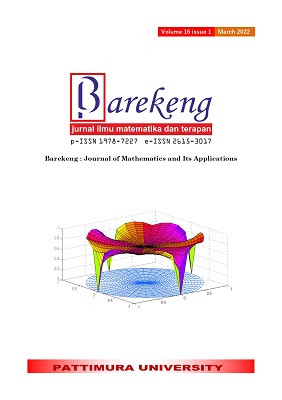3-PARAMETER GAMMA REGRESSION MODEL FOR ANALYZING HUMAN DEVELOPMENT INDEX OF CENTRAL JAVA PROVINCE
Abstract
The number and quality of the population are one of the determining factors for the success of national development. The quality of the population of a region can be seen from Human Development Index (HDI) achieved by a region. The HDI is based on three basic dimensions: a long and healthy life, knowledge, and a decent standard of living. This study aimed to determine the factors influencing HDI in Central Java Province in 2018-2020. The data used tend to follow the 3-Parameter Gamma distribution, which implies the HDI is modeled with 3-Parameter Gamma regression. 3-Parameter Gamma Regression is a regression that explains the relationship among one or more predictor variables with response variables that follow the 3-Parameter Gamma distribution. This research also includes the preparation of algorithms and computations in modeling 3-parameter Gamma regression. The estimation of model parameters was carried out using Maximum Likelihood Estimation (MLE) and Berndt Hall Hausman (BHHH) methods. HDI modeling with 3-Parameter Gamma regression produces a coefficient of determination of 61.58%. The results show that increasing HDI can be done by increasing the Pure Participation Rate (APM) for SMP/MTs, the ratio of SMP/MTs students, population density, Labor Force Participation Rate (TPAK), the percentage of households (RT) with access to water, drinking water, and the percentage of households (RT) that have their toilet facilities, as well as by reducing the student-teacher ratio of Junior High School(SMP)/Islamic Junior High School (MTs) and the Open Unemployment Rate (TPT).
Downloads
References
BPS, Statistik Indonesia dalam Infografis 2020 [Indonesia Statistics in Infographics 2020]. Jakarta: Badan Pusat Statistik, 2020.
A. Melliana and I. Zain, “Analisis Statistika Faktor yang Mempengaruhi Indeks Pembangunan Manusia di Kabupaten / Kota Provinsi Jawa Timur dengan Menggunakan Regresi Panel,” ["Statistical Analysis of Factors Affecting the Human Development Index in Regencies / Cities of East Java Province by Using Panel Regression,"] vol. 2, no. 2, pp. 237–242, 2013.
N. P. D. Yanthi and I. N. Budiantara, “Pemodelan Faktor - Faktor yang Mempengaruhi Indeks Pembangunan Manusia Menggunakan Regresi Nonparametrik Spline di Jawa Tengah,” ["Modeling Factors Affecting Human Development Index Using Nonparametric Spline Regression in Central Java,"] J. Stat. dan Seni ITS, vol. 5, no. 2, pp. 157–162, 2016.
R. Zakaria, “Pengaruh Tingkat Jumlah Penduduk, Pengangguran, Kemiskinan, Pertumbuhan Ekonomi, dan Belanja Modal Terhadap Indeks Pembangunan Manusia di Provinsi Jawa Tengah Tahun 2010-2016.” ["The Influence of Population Level, Unemployment, Poverty, Economic Growth, and Capital Expenditure on the Human Development Index in Central Java Province in 2010-2016."] 2018.
D. E. Putri, Purhadi, and D. D. Prastyo, “Parameter estimation and hypothesis testing on geographically weighted gamma regression,” J. Phys. Conf. Ser., vol. 893, p. 12025, 2017.
A. S. Nasution, Purhadi, and Sutikno, “Estimasi Parameter Dan Pengujian Hipotesis Pada Model Regresi Gamma (Studi Kasus: Pemodelan Pencemaran Sungai Di Surabaya),” ["Parameter Estimation and Hypothesis Testing in the Gamma Regression Model (Case Study: River Pollution Modeling in Surabaya)," Paid. J. Pendidik., vol. 2, no. 2, pp. 17–26, 2017.
R. Shanker and K. K. Shukla, “On modeling of lifetime data using three-parameter generalized lindley and generalized gamma distributions,” vol. 4, no. 7, pp. 283–288, 2016.
E. W. Stacy, “A Generalization of the Gamma Distribution,” Ann. Math. Stat., vol. 33, no. 3, pp. 1187–1192, 1962.
A. M. Mathai and P. G. Moschopoulos, “A Form of Multivariate Gamma Distribution,” Ann. Inst. Stat. Math., vol. 44, no. 1, pp. 97–106, 1992.
A. Rahayu, Purhadi, Sutikno, and D. D. Prastyo, “Multivariate gamma regression: Parameter estimation, hypothesis testing, and its application,” Symmetry (Basel)., vol. 12, no. 5, 2020.
G. H. Wenur, Purhadi, and A. Suharsono, “Three-parameter bivariate gamma regression model for analyzing under-five mortality rate and maternal mortality rate,” J. Phys. Conf. Ser., vol. 1538, no. 1, 2020.
Purhadi, A. Rahayu, and G. H. Wenur, “Geographically weighted three-parameters bivariate gamma regression and its application,” Symmetry (Basel)., vol. 13, no. 2, pp. 1–17, 2021.
A. C. Cameron and P. K. Trivedi, Microeconomics Methods and Applications. Cambridge: Cambridge University Press, 2005.
H. Akaike, “A new look at the statistical model identification,” IEEE Trans. Automat. Contr., vol. 19, no. 6, pp. 716–723, 1974.
M. Mittlböck and H. Heinzl, “MEASURES OF EXPLAINED VARIATION IN GAMMA REGRESSION MODELS,” Commun. Stat. - Simul. Comput., vol. 31, no. 1, pp. 61–73, Mar. 2002.
F. Aucoin, “Package ‘ FAdist .’” 2020.
M. Corrales and E. Cepeda-Cuervo, “Package ‘ Gammareg .’” 2020
Authors who publish with this Journal agree to the following terms:
- Author retain copyright and grant the journal right of first publication with the work simultaneously licensed under a creative commons attribution license that allow others to share the work within an acknowledgement of the work’s authorship and initial publication of this journal.
- Authors are able to enter into separate, additional contractual arrangement for the non-exclusive distribution of the journal’s published version of the work (e.g. acknowledgement of its initial publication in this journal).
- Authors are permitted and encouraged to post their work online (e.g. in institutional repositories or on their websites) prior to and during the submission process, as it can lead to productive exchanges, as well as earlier and greater citation of published works.






1.gif)



